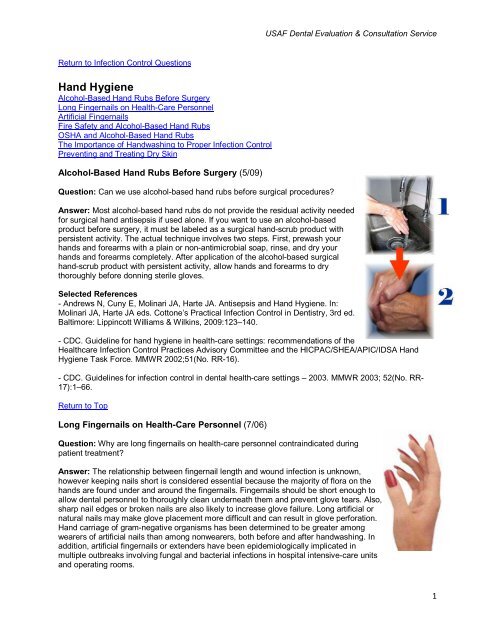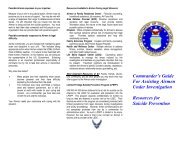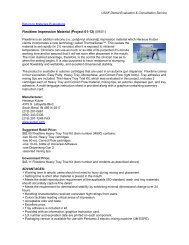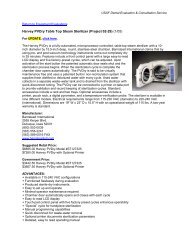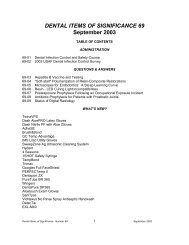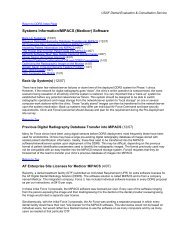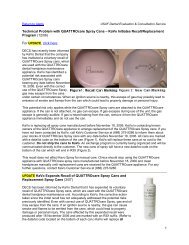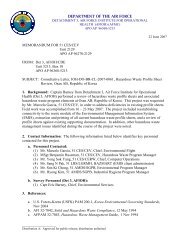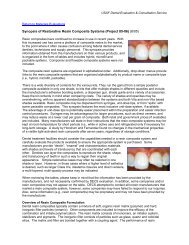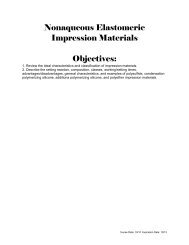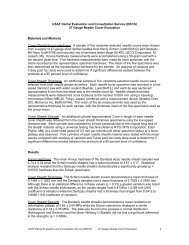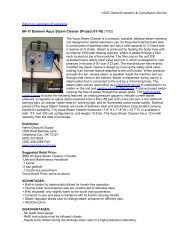Hand Hygiene
Hand Hygiene
Hand Hygiene
Create successful ePaper yourself
Turn your PDF publications into a flip-book with our unique Google optimized e-Paper software.
Return to Infection Control Questions<br />
<strong>Hand</strong> <strong>Hygiene</strong><br />
Alcohol-Based <strong>Hand</strong> Rubs Before Surgery<br />
Long Fingernails on Health-Care Personnel<br />
Artificial Fingernails<br />
Fire Safety and Alcohol-Based <strong>Hand</strong> Rubs<br />
OSHA and Alcohol-Based <strong>Hand</strong> Rubs<br />
The Importance of <strong>Hand</strong>washing to Proper Infection Control<br />
Preventing and Treating Dry Skin<br />
Alcohol-Based <strong>Hand</strong> Rubs Before Surgery (5/09)<br />
Question: Can we use alcohol-based hand rubs before surgical procedures?<br />
USAF Dental Evaluation & Consultation Service<br />
Answer: Most alcohol-based hand rubs do not provide the residual activity needed<br />
for surgical hand antisepsis if used alone. If you want to use an alcohol-based<br />
product before surgery, it must be labeled as a surgical hand-scrub product with<br />
persistent activity. The actual technique involves two steps. First, prewash your<br />
hands and forearms with a plain or non-antimicrobial soap, rinse, and dry your<br />
hands and forearms completely. After application of the alcohol-based surgical<br />
hand-scrub product with persistent activity, allow hands and forearms to dry<br />
thoroughly before donning sterile gloves.<br />
Selected References<br />
- Andrews N, Cuny E, Molinari JA, Harte JA. Antisepsis and <strong>Hand</strong> <strong>Hygiene</strong>. In:<br />
Molinari JA, Harte JA eds. Cottone’s Practical Infection Control in Dentistry, 3rd ed.<br />
Baltimore: Lippincott Williams & Wilkins, 2009:123–140.<br />
- CDC. Guideline for hand hygiene in health-care settings: recommendations of the<br />
Healthcare Infection Control Practices Advisory Committee and the HICPAC/SHEA/APIC/IDSA <strong>Hand</strong><br />
<strong>Hygiene</strong> Task Force. MMWR 2002;51(No. RR-16).<br />
- CDC. Guidelines for infection control in dental health-care settings – 2003. MMWR 2003; 52(No. RR-<br />
17):1–66.<br />
Return to Top<br />
Long Fingernails on Health-Care Personnel (7/06)<br />
Question: Why are long fingernails on health-care personnel contraindicated during<br />
patient treatment?<br />
Answer: The relationship between fingernail length and wound infection is unknown,<br />
however keeping nails short is considered essential because the majority of flora on the<br />
hands are found under and around the fingernails. Fingernails should be short enough to<br />
allow dental personnel to thoroughly clean underneath them and prevent glove tears. Also,<br />
sharp nail edges or broken nails are also likely to increase glove failure. Long artificial or<br />
natural nails may make glove placement more difficult and can result in glove perforation.<br />
<strong>Hand</strong> carriage of gram-negative organisms has been determined to be greater among<br />
wearers of artificial nails than among nonwearers, both before and after handwashing. In<br />
addition, artificial fingernails or extenders have been epidemiologically implicated in<br />
multiple outbreaks involving fungal and bacterial infections in hospital intensive-care units<br />
and operating rooms.<br />
1
USAF Dental Evaluation & Consultation Service<br />
USAF Guidelines for Infection Control in Dentistry<br />
- Keep fingernails short with smooth, filed edges to allow thorough cleaning and prevent glove tears. Long<br />
nails make glove placement more difficult and may result in glove perforation. Follow MTF policy<br />
regarding artificial fingernails. Use of artificial fingernails is usually not recommended.<br />
- Chipped nail polish can harbor bacteria. Unchipped nail polish on short natural nails is acceptable.<br />
Selected References<br />
1. CDC. Guideline for hand hygiene in health-care settings: recommendations of the Healthcare Infection<br />
Control Practices Advisory Committee and the HICPAC/SHEA/APIC/IDSA <strong>Hand</strong> <strong>Hygiene</strong> Task Force.<br />
MMWR 2002;51(No. RR-16).<br />
2. CDC. Guidelines for infection control in dental health-care settings - 2003. MMWR 2003; 52(No. RR-<br />
17).<br />
3. Foca M, Jakob K, Whittier S, et al. Endemic Pseudomonas aeruginosa infection in a neonatal intensive<br />
care unit. N Engl J Med 2000;343:695-700.<br />
4. Hedderwick SA, McNeil SA, Lyons MJ, Kauffman CA. Pathogenic organisms associated with artificial<br />
fingernails worn by healthcare workers. Infect Control Hosp Epidemiol 2000;21:505-9.<br />
5. Larson EL. APIC guideline for hand washing and hand antisepsis in health-care settings. Am J Infect<br />
Control 1995;23:251-69.<br />
6. McGinley KJ, Larson EL, Leyden JJ. Composition and density of microflora in the subungual space of<br />
the hand. J Clin Microbiol 1988;26:950-3.<br />
7. McNeil SA, Foster CL, Hedderwick SA, Kauffman CA. Effect of hand cleansing with antimicrobial soap<br />
or alcohol-based gel on microbial colonization of artificial fingernails worn by health care workers. Clin<br />
Infect Dis 2001;32:367-72.<br />
8. Moolenaar RL, Crutcher M, San Joaquin VH, et al. A prolonged outbreak of Pseudomonas aeruginosa<br />
in a neonatal intensive care unit: did staff fingernails play a role in disease transmission? Infect Control<br />
Hosp Epidemiol 2000;21:80-5.<br />
9. Parry MF, Grant B, Yukna M, et al. Candida osteomyelitis and diskitis after spinal surgery: an outbreak<br />
that implicates artificial nail use. Clin Infect Dis 2001;32:352-7.<br />
10. Passaro DJ, Waring L, Armstrong R, et al. Postoperative Serratia marcescens wound infections<br />
traced to an out-of-hospital source. J Infect Dis 1997;175:992-5.<br />
11. Pottinger J, Burns S, Manske C. Bacterial carriage by artificial versus natural nails. Am J Infect<br />
Control 1989;17:340-4. 12. Rubin DM. Prosthetic fingernails in the OR: a research study. AORN J<br />
1988;47:944-5.<br />
Return to Top<br />
Artificial Fingernails (7/06)<br />
Question: We do not allow artificial nails to be worn in our dental clinic. An assistant recently had an<br />
"acrylic" substance added to her natural nails, is this considered to<br />
be an artificial fingernail or is it "ok" to wear?<br />
Answer: According to the USAF Guidelines for Infection Control in<br />
Dentistry artificial nails are defined as substances or devices<br />
applied or added to the natural nails to augment or enhance the<br />
wearer's own nails including but not limited to, bondings, tips,<br />
wrappings, and tapes. After about a week the acrylic substance can<br />
lift, crack, or peel up allowing debris to enter into the space<br />
between the acrylic and the natural nail. This results in bacteria and moisture accumulating under and in<br />
the acrylic compound. Therefore, adding an acrylic substance to the natural fingernail is considered to be<br />
an artificial product, and therefore would not be acceptable.<br />
Return to Top<br />
2
Fire Safety and Alcohol-Based <strong>Hand</strong> Rubs (7/04)<br />
USAF Dental Evaluation & Consultation Service<br />
Question: I’ve read that it is unsafe to use alcohol-based hand rubs in health-care settings because of<br />
the fire risk. Is there any new information about safety precautions that we should take to minimize the<br />
risk of fire if using alcohol-based hand rubs?<br />
Answer: In Europe, where alcohol-based hand rubs have been used extensively for years, the incidence<br />
of fires associated with such products has been low. 1 The results of a recent survey in the U.S. also<br />
supports this. 2 However, since alcohols are flammable, precautions should be taken<br />
to minimize any potential fire risk. Recently, the National Fire Protection Association<br />
(NFPA) published amended guidance to the Life Safety Code (LSC) allowing alcoholbased<br />
hand rubs in health-care facilities if several safety conditions are met: 3<br />
- The egress corridor width is 6 feet or greater and dispensers are separated at least<br />
4 feet apart.<br />
- The maximum individual dispenser fluid capacity is 1.2 liters for dispensers in<br />
rooms, corridors, and areas open to corridors, and 2.0 liters for dispensers in suites<br />
of rooms.<br />
- If using wall-mounted dispensers, do not install over or directly adjacent to electrical outlets and<br />
switches.<br />
- In locations with carpeted floor coverings, dispensers installed directly over carpeted surfaces are<br />
permitted only in areas with sprinklers.<br />
- Each smoke compartment may contain a maximum aggregate of 10 gallons of alcohol-based hand rub<br />
solution in dispensers and a maximum of 5 gallons in storage.<br />
Adherence of health-care personnel to recommended hand-hygiene procedures has been poor with an<br />
overall average rate of 40% in hospital settings. Common self-reported reasons are the lack of sinks,<br />
soap, and paper towels. Alcohol-based hand rubs have been proven effective and they may help improve<br />
adherence to hand-hygiene protocols in many health-care settings. Although alcohol-based hand rubs<br />
have the potential to increase hand hygiene compliance, sinks and other hand-hygiene supplies are<br />
readily available in dental operatories, making the use of these waterless hand-hygiene agents optional.<br />
In dental settings, alcohol-based hand rubs may be useful in exam rooms or radiology work areas where<br />
multiple patients are seen in a short period of time and frequent handwashing is indicated. Another<br />
indication may be in dental residencies where staff members perform frequent patient checks. Because<br />
dispensers should not be installed near electrical outlets and the restrictions on the amount of product in<br />
operatories, dental clinics may want to consider using smaller pump dispensers instead of purchasing<br />
wall-mounted dispensing systems. In summary, careful evaluation and ongoing educational and<br />
motivational programs to maintain awareness of the importance of hand hygiene are indicated before<br />
deciding to introduce alcohol-based hand rubs into a dental practice.<br />
References<br />
1. Widmer AF. Replace hand washing with use of a waterless alcohol hand rub? Clin Infect Dis<br />
2000;31:136–143.<br />
2. Boyce JM, Pearson ML. Low frequency of fires from alcohol-based hand rub dispensers in healthcare<br />
facilities. Infect Control Hosp Epidemiol 2003;24:618–619.<br />
3. Air Force Medical Logistics Letter (AFMLL) 05-2004. May 2004.<br />
Return to Top<br />
3
OSHA and Alcohol-Based <strong>Hand</strong> Rubs (1/04)<br />
USAF Dental Evaluation & Consultation Service<br />
Question: Is the use of alcohol-based hand rubs consistent with the requirements for handwashing<br />
established in OSHA’s Bloodborne Pathogen Standard?<br />
Answer: OSHA recently posted an interpretation letter on their Web site addressing<br />
this issue. OSHA states that when an employee is removing gloves and has had<br />
contact, meaning occupational exposure to blood or other potentially infectious<br />
materials (OPIM), hands must be washed with an appropriate soap and running<br />
water. If there has been no occupational exposure to blood or OPIM, antiseptic hand<br />
cleansers may be used as an appropriate "handwashing" practice. The key is<br />
occupational exposure to or potential exposure to blood or OPIM. If gloves are intact<br />
upon removal, the use of an alcohol-based hand rub product for hand hygiene is<br />
acceptable. If your gloves become torn during the procedure, washing your hands<br />
with soap and water after removing the torn gloves and before donning new gloves<br />
is indicated. Additionally, if you notice a hole in your gloves upon removal, washing<br />
your hands with soap and water is indicated.<br />
The 03/31/2003 OSHA interpretation letter—Acceptable use of antiseptic-hand<br />
cleansers for bloodborne pathogen decontamination and as an appropriate handwashing practice—can<br />
be found by visiting www.osha.gov).<br />
Return to Top<br />
The Importance of <strong>Hand</strong>washing to Proper Infection Control (Updated September 2004)<br />
Question: I always wear gloves during patient treatment. Is handwashing really that important?<br />
Answer: Yes, handwashing is the single most important procedure for preventing health-care<br />
associated infections. <strong>Hand</strong>s of dental health-care personnel can carry bacteria, viruses, and fungi that<br />
are potentially infectious to them and their patients. <strong>Hand</strong>washing is recommended before and after<br />
situations in which hands are likely to become contaminated with blood, body fluids/secretions, or saliva.<br />
Also they should be washed when contacting contaminated items, instruments, or equipment. Always<br />
wash your hands before and after wearing gloves. Gloves are not a substitute for handwashing.<br />
Return to Top<br />
Preventing and Treating Dry Skin (Originally published in the Jan 2003 issue of InCONTROL)<br />
Question: Are there recommendations for preventing and treating dry skin that is common during the<br />
winter months?<br />
Answer: With the cooler temperatures, many of us are experiencing dry skin<br />
and subsequent dermatitis most likely resulting from frequent handwashing and<br />
glove use. Dental health-care personnel (DHCP) have the potential to wash<br />
their hands over 30 times during a typical workday. This can contribute to<br />
irritant contact dermatitis, which usually appears as reddened, dry, or chapped<br />
skin. Factors such as cold weather and low humidity may also contribute to the<br />
problem. Prevention is the key, because dry, irritated skin discourages proper<br />
hand hygiene and may harbor potentially pathogenic organisms. Also, if the<br />
problem is allowed to become chronic, the irritation may progress to<br />
hypersensitivity.<br />
Lotions are recommended to ease the dryness resulting from frequent<br />
4
USAF Dental Evaluation & Consultation Service<br />
handwashing and, more recently, to prevent dermatitis resulting from glove use. Petroleum-based lotion<br />
formulations, however, can weaken latex gloves and cause increased permeability. For that reason,<br />
lotions containing petroleum or other oil emollients may affect the integrity of gloves and should not be<br />
used. At the time of product selection, information should be obtained from the manufacturer regarding<br />
interaction between gloves and lotions.<br />
DHCP with open sores or weeping dermatitis must refrain from direct patient contact and handling of<br />
patient care equipment until the condition has resolved. Evaluation by a qualified health-care professional<br />
is necessary if DHCP experience repeated or unresolved hand irritation.<br />
Some preventive measures include:<br />
-Washing with cool or tepid water<br />
-Wetting hands thoroughly before applying the handwashing agent<br />
-Thoroughly rinsing off all handwashing agents with cool water<br />
-Gently drying hands (vs. rubbing) with disposable soft materials<br />
-Drying hands completely before donning gloves<br />
-Wearing protective gloves when cleaning or handling chemicals<br />
-Using water-based skin care products<br />
References and Additional Resources<br />
1. CDC. Guideline for hand hygiene in health-care settings: recommendations of the healthcare infection<br />
control practices advisory committee and the HICPAC/SHEA/APIC/IDSA hand hygiene task force.<br />
MMWR 2002;51 (No. RR-16): 1-45.<br />
2. Larson EL, 1992, 1993, and 1994 Association for Professionals in Infection Control and Epidemiology<br />
Guidelines Committee. APIC guideline for hand washing and hand antisepsis in health-care settings. Am<br />
J Infect Control 1995;23:251-69.<br />
3. Molinari JA, Rosen S, Runnells RR. Chemical sterilization, disinfection, and antisepsis. In: Cottone JA,<br />
Terezhalmy GT, Molinari JA, eds. Practical infection control in dentistry, 2nd ed. Baltimore: Williams &<br />
Wilkins, 1996: 161-75.<br />
Return to Top<br />
5


